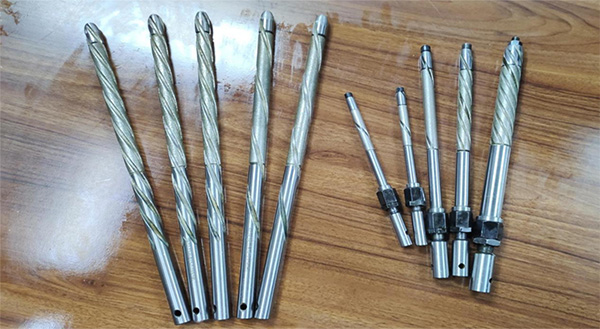Comparison between diamond honing rod and ordinary reamer


1. Materials
Diamond honing rod: Diamond is used as abrasive and is usually fixed to the substrate by electroplating or sintering.
Ordinary reamer: Generally made of high-speed steel or cemented carbide, it has high hardness and toughness, but not as hard as diamond.
2. Cutting method
Diamond honing rod: Mainly removes materials by grinding, suitable for fine material removal and surface finish improvement.
Ordinary reamer: Removes materials by cutting, and achieves processing by cutting materials with the blade.
3. Applicable materials
Diamond honing rod: Suitable for processing high-hardness materials (such as hardened steel, quenched and tempered steel, cast iron, ductile iron, cemented carbide, ceramics, etc.).
Ordinary reamer: Suitable for processing medium-hardness materials (such as steel, cast iron, aluminum alloy, etc.).
4. Processing accuracy and surface quality
Diamond honing rod: Can achieve high processing accuracy (usually at the micron level) and surface finish.
Ordinary reamer: The processing accuracy and surface quality are limited by the tool material and design, and are usually not as fine as diamond honing rods.
5. Service life
Diamond honing rod: Since diamond is one of the hardest materials, it has a long service life and excellent wear resistance.
Ordinary reamer: The service life is relatively short, especially when processing high-hardness materials, it is easy to wear.
6. Processing speed
Diamond honing rod: The grinding process may be slightly slower than cutting, but it can ensure higher processing quality.
Ordinary reamer: The cutting speed is fast, suitable for removing a large amount of material, but the surface quality may not be as good as the honing effect.
7. Cost
Diamond honing rod: The initial cost is higher, but due to its long life and high precision, it may be better in terms of overall economic efficiency.
Ordinary reamer: The initial cost is low, but frequent replacement, large fluctuations in processing quality, and long-term costs may be high.
Advantages of Halnn Diamond Honing Rods
1. High hardness and wear resistance
Halnn superhard diamond honing rods use diamond as abrasive, which is harder than any other material, giving it excellent wear resistance and life. Suitable for processing high-hardness materials that usually cause severe wear to ordinary reamers.
2. High processing accuracy
Halnn superhard diamond honing rods have grinding characteristics that can achieve extremely high processing accuracy and micron-level dimensional control, suitable for processing tasks with extremely high precision requirements.
3. Excellent surface finish
Due to the fine particles of diamond that can be finely ground, diamond honing rods can provide very smooth surfaces, suitable for applications with high requirements for surface quality, such as the processing of optical components and precision mechanical parts.
4. Adaptability to multiple materials
Halnn superhard diamond honing rods are suitable for a variety of difficult-to-process materials, including high-hardness alloys, ceramics, glass, etc., on which ordinary reamers have relatively poor processing performance.
5. Stable processing performance
The grinding method and material properties of diamond honing rods ensure their stability under high load and high speed conditions, reduce the generation of errors during processing, and improve processing consistency.
6. Wide range of applications
Diamond honing rods can adapt to various precision processing environments, especially in the field of micro-processing of superhard materials, where ordinary reamers are often unable to cope.
Summary: Diamond honing rods have significant advantages in high-precision machining, surface finish, material adaptability and service life, and are particularly suitable for applications with high-hardness materials and high-precision requirements. In contrast, although ordinary reamers may have certain advantages in initial cost and processing speed, they are limited in precision, wear resistance and overall economy. Therefore, it is crucial to choose the right tool type according to specific processing requirements. In the processing of high-precision and high-hardness materials, diamond honing rods are undoubtedly a better choice.
For all inquiries, please fill in the form below (* are required) to send us a brief message, and we will get back to you as soon as possible.